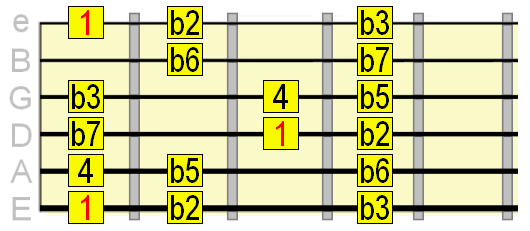The
Locrian
Mode
Theory
Below is a diagram showing the intervals of the major scale. Each yellow box can be seen as a
degree of the major scale, so each one also represents a mode, from 1 (Ionian) to 7 (
Locrian
) and then back to 1 again.
The numerals correspond to the chord/mode number 1-7. You can also see that the maj/min label
corresponds with the chord/mode type (the triad around which the mode is built). For example,
3rd mode Phrygian is a minor mode, so therefore the 3 (iii) chord will also be minor. 4th mode
Lydian is a major mode, so therefore the 4 (IV) chord will also be major!
It's just like superimposing chords onto the mode patterns,
using some or all of the mode's tones in the chord.

Because you can never really resolve a chord progression to a diminished tonic (it sounds too unresolved),
Locrian
is most commonly used to compliment diminished chords as a bridge between two more stable chords.
The diminished flavour acts predominantly as a natural, passing link to the major tonic of the chord progression
(which is C major in this case). It also acts as a natural, passing link to Aeolian (minor) of the same key.
Locrian
can complement that movement over the leading diminished chord.

